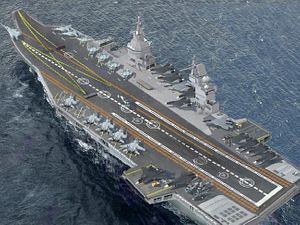India is slated to announce a public tender to assist its indigenous defense industry in building the country’s fourth aircraft carrier, with a Russian supercarrier design as the front-runner, RT reports.
The news that New Delhi will shortly be announcing a procurement tender for a heavy nuclear-powered aircraft carrier, 300 meters long and 70 meters wide and displacing 65,000 tons, was first reported by the French defense industry bulletin TTU at the beginning of March.
According to Izvestia newspaper, the Krylovsky State Research Center (KRSC), a Russian shipbuilding research and development institute, will be offering its supercarrier design called Project 23000E Shtorm (Storm) to the Indian Navy, which plans to induct the new vessel in the late 2020s.
This new supercarrier will purportedly feature significant design changes from the lead vessel in its class, the INS Vikrant, including possible nuclear propulsion and Catapult Assisted Take-Off But Arrested Recovery (CATOBAR) and Electromagnetic Aircraft Launch Systems (EMALS).
In the summer of 2015, Russia, France, the United Kingdom, and the United States received requests for “technical and costing proposals” regarding the design of India’s new aircraft carrier. According to Indian defense officials, the two top contenders are Russia and France, given that India operates aircraft from both countries.
As I reported previously (See: “India to Consider French Fighter Jets For Navy’s Newest Aircraft Carrier”), representatives of French aircraft maker Dassault Aviation pitched the naval version of the Dassault Rafale twin-engine, fourth generation multirole fighter to the Indian Navy in late January.
Izvestia claims that Russia is currently the top contender. “The Russian design dovetails with Indian Prime Minister Narendra Modi’s concept ‘Make in India,’” according to a Russian naval analyst quoted in the newspaper. “At present, only Moscow is ready to share with New Delhi both weapons and other systems, on the one hand, and their development and manufacturing technologies, on the other.”
Russia’s new supercarrier design was first revealed in May 2015. “The Project 23000E multipurpose aircraft carrier is designed to conduct operations in remote and oceanic areas, engage land-based and sea-borne enemy targets, ensure the operational stability of naval forces, protect landing troops, and provide the anti-aircraft defense,” according to a representative of KRSC interviewed by IHS Jane’s Defense Weekly.
The supercarrier design has a displacement of 100,000 tons, is 330 meters long, 40 meters wide, and has a draft of 11 meters. Powered by either conventional or a nuclear propulsion, the ship can remain at sea for 120 days and sail up to 30 knots (around 55 kilometers per hour), according to information supplied by KRSC. It can accommodate a crew of up to 5,000 and can carry 80-90 deck-based aircraft.
The likelihood that Russia’s supercarrier project will become a reality and move beyond the conceptual state is slim. For starters, Russia has never built an aircraft carrier. All Soviet carriers were constructed in Ukraine. Russia’s shipbuilding industry currently lacks the capacity to build a supercarrier and does not even have a large enough dry dock to accommodate a vessel the size of the Shtorm.
Russia, however, has overhauled and modernized a Kiev-class carrier-cruiser, renamed INS Vikramaditya, for the Indian Navy from 2004-2013 and gained valuable insights into carrier building techniques through that process. This expertise can now prove to be an asset in helping sway Indian opinion. Consequently, even if the Project 23000E Shtorm proposal may ultimately prove not to be implementable, Russia is still a serious contender in the bid to build India’s next aircraft carrier.































